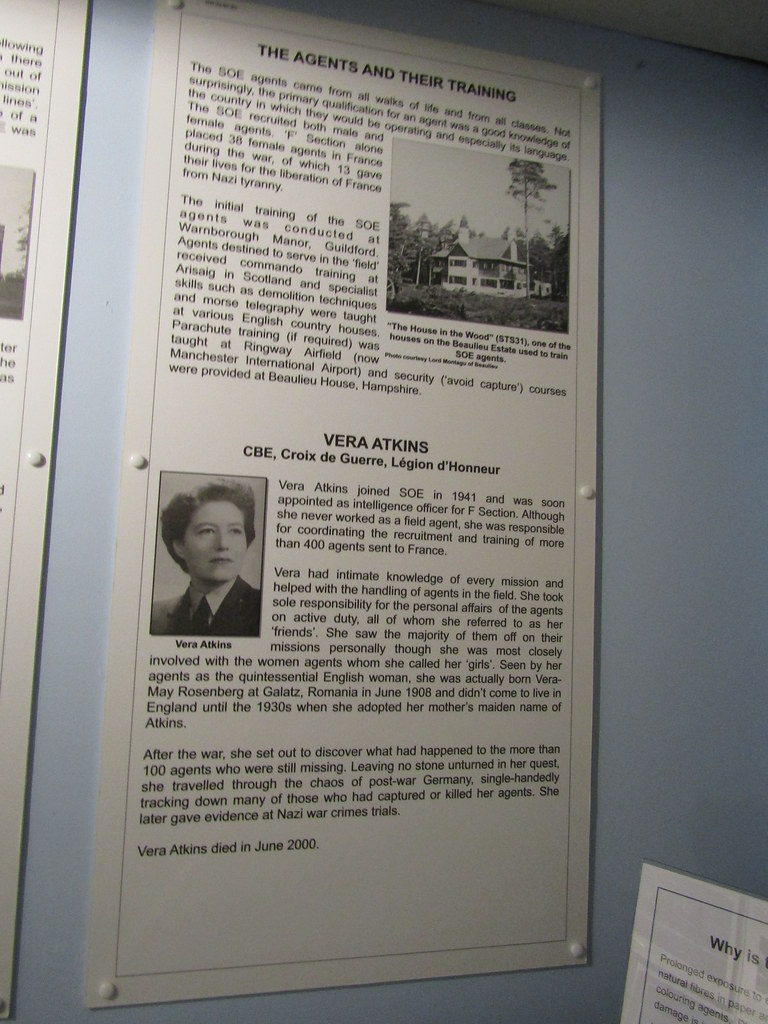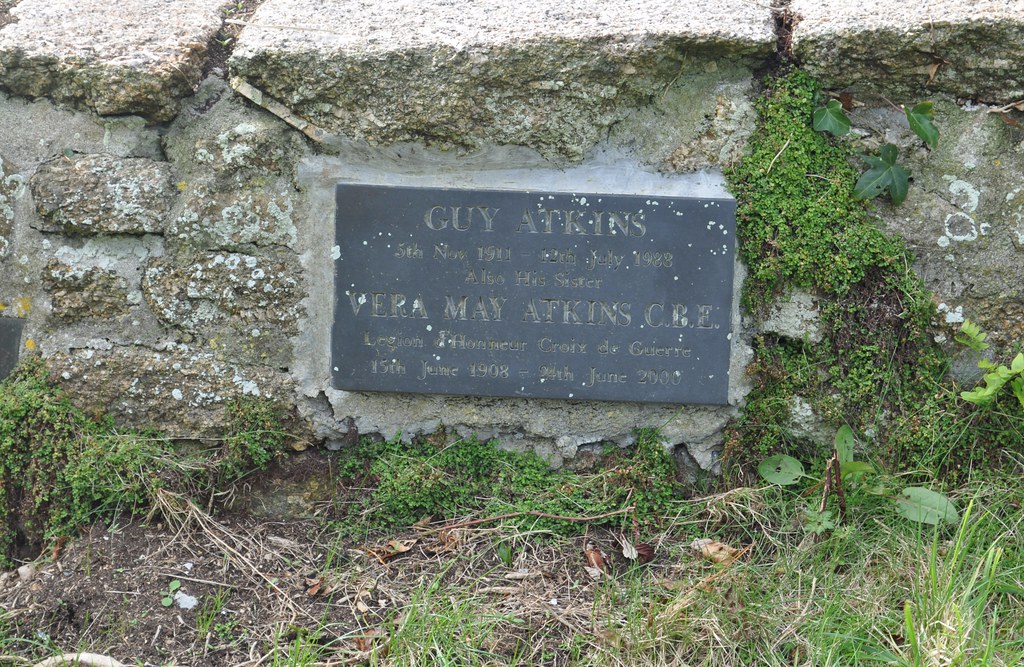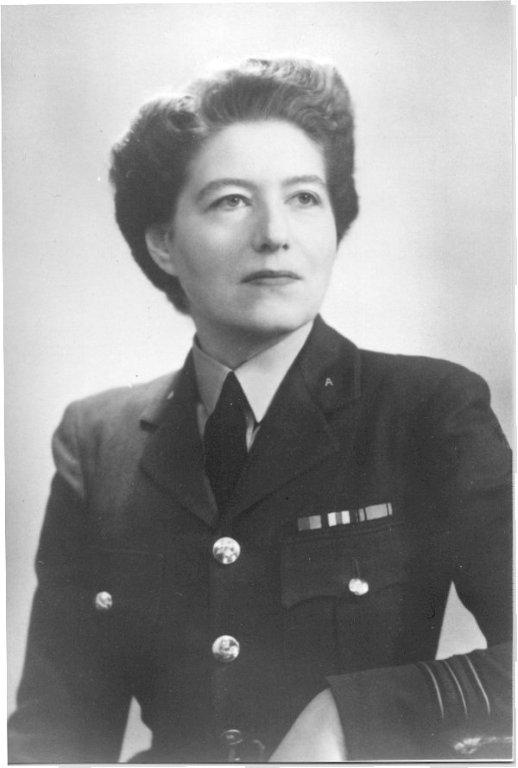May of 1945 marked the end of World War II in Europe. It was a time of relief for many, but not for Vera Atkins. For her, a war was still raging, and she was off to a new front. She set off for Germany at the end of the war to find her missing agents, with whom, over time, she had become very close. Vera Atkins was a member of the Special Operations Executive (SOE). It was a secret British organization that was created in July 1940. Its purpose was to conduct espionage and sabotage in German-occupied Europe.1
In February of 1941, Vera Atkins joined the SOE as a secretary in the French section (F section) of the organization even though she herself was of British origin. She worked under Colonel Maurice Buckmaster, who was the head of the F section and eventually was commissioned in the Women’s Auxiliary Air Force as a Flight Officer in 1944. She then continued her work in the SOE and was later promoted to being an intelligence officer in the F section with the task of recruiting and deploying British agents in occupied France to complete missions. The main role Atkins played for the Special Operations Executive was recruiting and employing British agents in France along with being responsible for the thirty-seven total women who were SOE agents working as couriers and wireless operators. They were tasked with creating acts of sabotage, gathering information on the enemy, and/or providing aid to the French resistance.2
She became close to her agents as an intelligence officer by making sure that each one them was fully prepared for his or her mission. Atkins would check everything from their clothes to papers and even took care of sending letters to their respective families. Furthermore, Atkins would accompany her agents to airfields and further check safety precautions. Everyday, Atkins attended daily section-head meetings Buckmaster led. She usually stayed up late at night in the signals room to receive transmissions agents often sent from the field that had already been decoded.3 Vera’s agents became her children in a sense. She would take the time to know the girls like the back of her hand and prep them for their missions. If there was anyone that would be able to find out what eventually became of these girls, it would be Vera.

Major Anghais Fyffe left Bad Oeynhausen to meet Vera in Berlin on December 1, 1945. He was a former SOE security director and had been assigned to find missing SOE agents. His former boss had been Commander John Senter until Vera Atkins started reaching out to him from London. Vera sent him a teleprint list of names in respect to missing F section men and women. She sought answers from Fyffe in regard to how these men and women truly died. For example, could Fyffe confirm that Cicely Left was gassed in the Jugendlager at Ravensbrüik? Other demands she asked of him were in regard to him arranging an interrogation for her to keep finding answers to her questions.4
After asking for answers, Vera wanted to take matters into her own hands even though her mission had not received approval. Then an event occurred that helped Vera’s search get put into action. Charles Bushell, Violet Szabo’s father, was adamant about figuring out what had happened to her daughter. Violet had been one of Atkin’s women spies. He began to ask around for answers to his questions and the SOE worried it would get to the government, due to it still being a secret that British women had been deployed behind enemy lines. Vera decided it was now time to begin her investigation as soon as it was approved, and travel to Germany’s British zone.5
It was early in December of 1945 when she began her search. The first person she wanted to find out what had happened was a man named Jumeau. When she met Major Fyffe, they went north of Berlin to look for his grave. After finding what she was looking for, Vera had information to bring back to her bosses and proof she could carry out her mission. Her next mission, as she informed Fyffe, was to interrogate the commandants of two concentration camps in an effort to gain more answers. She traveled to Bad Oeyenhausen in an effort to interrogate Fritz Suhren and Anton Kaindl to find out what had happened to agents Violette Szabo, Lilian Rolfe, Denise Bloch, and Odette Churchill, to name a few. Nothing had been heard about them. Unfortunately, these interrogations led to no new information about the missing agents. 6
Vera returned to London with an intention to return to Germany in the future; however, the SOE was set to close and no one would be able to pay for Vera’s mission. Despite this fact, Vera eventually traveled to see Yurka Galitzine, a journalist who had some details about some missing agents. Through him, Vera got information from a witness named Franz Berg who gave her information on how several women agents were killed in the concentration camp Natzweiler, some coming to an end in a crematorium, others shot or given lethal injections. Among those women killed, Vera Leigh and Nora Inayat Khan were thought to be them by Berg 7
When Vera took this information back to her superiors, they decided it was best for her to go back to Germany and continue her mission. Now Vera was set to be funded by MI6 and was set to be attached to the War Crimes Unit under a department of the British Army. She was also promoted from flight officer to squadron officer in order to hold more authority when conducting her search. Vera Atkins left London for the last time on January 8, 1946 with a list that had fifty-two missing SOE agents’ names. Twelve of those were women and most were from the F section. She was only given three months to discover their true fates. Vera’s first order of business was to figure out for a fact which agents died at Natzweiler. She was able to receive more information on this matter from Brian Stonehouse, a Jew who had survived four concentration camps and was able to describe a woman agent who Vera knew as Diana Rowden. Vera then took her search to a prison in Karlsruhe where several women agents were confirmed to have been held by a chief wardress. It was confirmed that Odette Churchill was imprisoned there during this time; however, more information was still needed. Vera then interviewed a woman named Hedwig Muller, who was imprisoned at the same time as some agents. Through her information, Vera was closer to identifying exactly which of her agents perished at Natzweiler.
By March 1946, Atkins still had a lot to uncover and her three months were quickly running out. She was told that a man by the name Johann Schwarzhuber was open to talking about what he saw at a camp in Ravensbrück. Since he was the camp overseer, Vera knew he would remember the girls and their fates that ended in death. Schwarzhuber was able to match names to pictures Vera showed him. He stated the names Lilian Rolfe, Denise Bloch, and Violette Szabo. He was even able to provide details on the cause of death of all three British agents. He described how they were all taken to the crematorium and shot one at a time. Vera wrote back to her superiors in London with instructions for them for acquiring proper death certificates and notifying their families. The case at Ravensbrück was now closed and Vera was making substantial progress.8
Vera then took to interrogating Franz Berg again, the crematorium stoker, in early April in hopes of confirming the agents who died in Natzweiler. Vera showed him pictures and his testimony seemed to match his first. On April 15 of 1946, Vera drafted and sent a note that stated that Vera Leigh, Diana Rowden, Andrée Borrel, and Nora Inayat Khan were among those killed on July 6, 1944. She had figured out the identities of these women and her goal of informing their next of kin was completed. Vera Atkins had figured out the identities of the women in Natzweiler, but she wanted to know the cause of the women’s deaths. Through further interrogations she discovered that the women were first injected with 10cc of Phenol and were then told they were injections against illness. After this, their bodies were taken to “the oven” to be burned. This marked another case done.9
After fully investigating what happened in Natzweiler, Atkins goal was to find out what happened to another group of women who left Karlsruhe prison in September 1944. These girls included Madeleine Damerment, Yolanda Beekman, and Eliane Plewman. There was more work to be done and her time of three months quickly came to an end in March. Thankfully, her investigation time was extended for another three months until June. Vera Atkins was doing amazing work and people were taking notice. Not only had she cleared up what happened at Ravensbrück and Natzweiler to her women agents, she also gathered evidence for trials in Flossenburg and Mauthausen, where a combined total of twenty-four F section men were killed.10
Soon, Vera Atkins made a breakthrough involving the case of the second group of women who were taken out of the Karlsruhe prison. She received a statement from a man named Christian Ott who was part of the Gestapo, or secret police of Nazi Germany. In it, he recalled how he transported the women to a camp named Dachau and the four girls were then shot to death. She confirmed his statement while interrogating Max Wassemer, who had supervised the initial transport of the girls. Vera Atkins was officially done with her last case and her work in Germany was over. The last thing she did to close her chapter in Germany, which was very important to her, was send a letter to the women’s next of kin. All the letters started with the following statement:
“It is with deepest regret that I have to inform you that your…. was killed in the early hours of… in the camp of….”11
However, although she was no longer in Germany, several events unfolded that led her to realize she had gotten Nora Inayat Khan’s manner of death wrong. She thought Nora was one of the girls that perished at Natzweiler however, this was not the case. Vera assumed that Sonia Olschanesky was an alias for Nora when she checked prison documents, but it was not. In 1947, Atkins went back to Bad Oeyenhausen to uncover the truth. She found out that Khan was detained with chains in Pforzheim in 1943. The final thing Vera did in regard to her investigation, and for the girls as a whole, was to make sure Nora Inayat Khan received a George Cross, an award of bravery and heroism. Vera Atkins had now completed what she set out to do. She uncovered the identity and fate of the women she had worked so closely with. She brought peace of mind to their families and made sure their legacy was honored.12

In an interview that Sarah Helms conducted, Vera Atkins states the following:
“I went to find them as a private enterprise. I wanted to know. I always thought ‘missing presumed dead’ to be such a terrible verdict.”
“I remember it was a bitterly cold day when I was collected by staff Sergeant Fyffe, who drove from Berlin, through the Russian zone, to bad Oeynhausen in the British zone. When we got there I said: Who is in charge here? I asked if he would have time to see Squadron officer Atkins.”
Atkins continues by saying, “I believe you have the camp commandants of Sachsenhausen and Ravensbruck in your custody. I would like to see them.” “He said: ‘They are tough nuts. One has escaped twice, and the other has not yet been interrogated.'” I said: ‘I want to see them anyway.’ Next I had to persuade him to let me work from his HQ. He said there was no room for another officer–especially a woman officer. But I persuaded him. I stayed there until I had traced every agent we had lost.”13
This interview was very valuable in that it gave insight into what Vera Atkin’s motivation was for finding the missing agents as well as the events that unfolded when she first arrived in Germany. Helms was one of the few authors who got to interview Atkins and review her personal notes and documents.
Vera Atkins retired in 1947 and went on to live a quiet life. In 1987, she was named a commandant of the French Legion of Honor and she settled down in a house southeast of England. Sarah Helm was able to interview her in 1998, as seen above, at the remarkable age of ninety years old. Two years later Vera Atkins passed away in Hastings, East Sussex, England, on June 24, 2000.14

Without Vera Atkin’s tenacity and resilience, what became of these girls would be unknown. No one told Vera to go out and seek answers; she decided to take on the responsibility herself. Thanks to her, the powerful and brave women’s deaths were not in vain and their strength and courage was honored and continues to be. She dedicated countless time and energy to a task whose outcome was extremely uncertain, yet she never gave up. Vera Atkins is the epitome of resilience and determination and her legacy will live on for years to come.
- William Stevenson, Spymistress: The True Story of the Greatest Female Secret Agent of World War II (New York: Arcade, 2011), 1-2. ↵
- Derwin Gregory, “Communicating with the European Resistance: An Assessment of the Special Operations Executive’s Wireless Facilities in the UK during the Second World War,” Post-Medieval Archaeology 50, no. 2 (November 2016): 289–291. ↵
- Sarah Helm, A Life in Secret: Vera Atkins and the Missing Agents of WWII (1st U.S. ed. Nan A. Talese/Doubleday, 2005), 24-26. ↵
- Sarah Helm, A Life in Secret: Vera Atkins and the Missing Agents of WWII (1st U.S. ed. Nan A. Talese/Doubleday, 2005), 330-337. ↵
- Sarah Helm, A Life in Secret: Vera Atkins and the Missing Agents of WWII (1st U.S. ed. Nan A. Talese/Doubleday, 2005), 336-337. ↵
- Sarah Helm, A Life in Secret: Vera Atkins and the Missing Agents of WWII (1st U.S. ed. Nan A. Talese/Doubleday, 2005), 343-345. ↵
- Sarah Helm, A Life in Secret: Vera Atkins and the Missing Agents of WWII (1st U.S. ed. Nan A. Talese/Doubleday, 2005), 348-354. ↵
- Sarah Helm, A Life in Secret: Vera Atkins and the Missing Agents of WWII (1st U.S. ed. Nan A. Talese/Doubleday, 2005), 291-293. ↵
- Sarah Helm, A Life in Secret: Vera Atkins and the Missing Agents of WWII (1st U.S. ed. Nan A. Talese/Doubleday, 2005), 478-482. ↵
- Sarah Helm, A Life in Secret: Vera Atkins and the Missing Agents of WWII (1st U.S. ed. Nan A. Talese/Doubleday, 2005), 487-488. ↵
- Sarah Helm, A Life in Secret: Vera Atkins and the Missing Agents of WWII (1st U.S. ed. Nan A. Talese/Doubleday, 2005), 511. ↵
- Shompa Lahiri, “Clandestine Mobilities and Shifting Embodiments: Noor-Un-Nisa Inayat Khan and the Special Operations Executive, 1940–44,” Gender & History 19 (2) (2007): 305–23 (2007); Sarah Helm, A Life in Secret: Vera Atkins and the Missing Agents of WWII (1st U.S. ed. Nan A. Talese/Doubleday, 2005), 624-626. ↵
- Sarah Helm, A Life in Secret: Vera Atkins and the Missing Agents of WWII (1st U.S. ed. Nan A. Talese/Doubleday, 2005), 27-28. ↵
- Douglas Martin, “Vera Atkins, 92, Spymaster for British, Dies,” The New York Times, June 27, 2000. https://www.nytimes.com/2000/06/27/world/vera-atkins-92-spymaster-for-british-dies.html. ↵



9 comments
Gisselle Baltazar-Salinas
Wow! This was extremely well written, I like that you chose to write about something with not enough attention. You should feel very proud. I can not believe there is not enough talk about this woman in history. I was in all with her leadership, courage and attention to detail. She truly deserve more credit that she has received in history. I felt you truly did a great job in telling her story. I was intrigued the entire time!
Victorianna Mejia
Such a great article! I love reading about women during World War II and how they contributed their energy to support one another. I loved reading about Vera Atkins and her persistence to find those who were classified as “missing presumed dead” and found their truth. I love that she never gave up on agents even after the war had ended. This was a great read, and I enjoyed learning the importance of her name.
Serenity Kamenski
Not to sound to sound like a cliche, but this article seems it would make a great spy movie to watch. However, although it would be an amazing movie to watch, Vera Atkin’s story is one of strength and the willpower to never give up despite the odds. It was kind of very sad to know that Atkin went through all this only to find most of her agents killed, which must have weighed heavily on her but at the same time give her a piece of mind on knowing what happened to them in the end. Great article by the way.
Carlos Hinojosa
This article was actually extremely interesting because I’ve honestly never heard of this woman. But from this article alone you could tell she was the definition of a great leader. Always checking her subordinates making sure there ready even taking care of any last statements to families. Like the article said you could tell she treated her subordinates as if they were her own children. That is a leader I would love to have and see. A very well-made article, good job.
Velma Castellanos
This is a great article!! I have never heard of Atkins until now but she is a very interesting women. I like how much of a leader she was and how she looked for her missing agents was admirable. She also reminds me of a guiding figure to her agents. I love reading about strong independent women because I like to be as independent as I can. Great job with listing your credits at the end.
Madeline Chandler
This is such a well written engaging article. Very captivating and informative. This article about Vera Atkins was so insight into such a strong, women of her time. I genuinely love that even though she was in charge she treated her agents almost as her child. I think she brought a strong yet maternal aspect into the field of Special Operations. Job well done! Enjoyed it!!
Phylisha Liscano
A very well written article and interesting. It was very fascinating to learn about Vera Atkins and her life. She played an excellent role for women. The amount of details your article included made this article come alive. I really enjoyed this article and it was by far one of the most exciting articles to read. Great article!
Madison Goza
What a well-written article! It was so cool to learn more about Vera Atkins and her extraordinary life and contributions. Her leadership and initiative to look for her missing agents is especially admirable. I really appreciate your thoroughness in explaining the lengths that Atkins went to search for her agents; it really helped me to imagine Atkins and her determination. Great article!
Isaac Fellows
It’s insane to me that we don’t hear about these kinds of stories more often. This should totally be a movie if it isn’t already! What a great article. I especially enjoyed the dialogue and use of imagery, it really did help to captivate me while reading. These kinds of stories really highlight the overlooked role of women in these kinds of expeditions.
Great article.